A heads-up on concussion risk
June 26, 2014
You’ve seen the recent headlines: Contact sports often lead to concussions, with possible long term effects. Earlier this month, former Miami Dolphins quarterback Dan Marino and 14 players became the latest to sue the NFL over concussions. Last year, PBS’ Frontline program League of Denial won a Peabody Award for investigating the NFL’s concussion crisis.
The story does not end with professional or even college sports: Studies show high school athletes are at double the risk of concussion as college players. Experts are also concerned about the cumulative effect of repeated concussion, which has been linked to temporary and permanent changes in the way the brain functions.
Heightened awareness is leading more young athletes to seek medical evaluation for possible concussions. The State of California has required concussion training for school coaches since Jan. 1, 2013.
Now, a new report by the Los Angeles County Department of Public Health provides a first-ever look at the problem of concussions in the L.A. region—and how rising awareness is leading to more and quicker treatment.
Overall, researchers found that 69,000 people were treated in emergency departments or admitted to hospitals in the county for concussions between 2005 and 2011. During that time, hospitalizations remained steady but the rate of emergency room visits soared by 58%–a finding that public health officials say reflects the public’s growing understanding of concussion symptoms and the importance of seeking medical attention.
By far, the highest rates of emergency visits were for young adults between the ages of 15 and 24. They accounted for nearly 30% of all such visits, almost twice as high as for any other age group. Roughly half of those individuals were hurt while playing football, with another 20% suffering injuries during soccer games. (Falls were the main cause of concussions among all age groups in L.A. County.)
While these findings were not unexpected for this younger age group, researchers were surprised by one unexplained discovery: Females, they found, reported more concussions than men in sports in which both play under similar rules, including basketball and soccer.
“It could be biomechanical, the way females are built versus males,” said Dr. Margaret Shih, director of the public health’s office of health assessment and epidemiology. She said it’s hard to draw a conclusion because women are traditionally more likely to seek medical help than men. “There’s still a lot of research that needs to be done,” she said.
County health officials say they hope their report will lead to heightened awareness not only in our emergency rooms, but on the playing field. And despite the rising numbers of emergency department visits, they think the numbers are still too low.
“I do believe that concussions are underreported,” said Andrea Welsing, director of the injury and violence prevention program for the public health department. She added that pressure to play is still keeping many injured athletes in the game, putting them at risk of further injury.
Although the report will not be distributed in hard-copy form, Welsing said the plan is to launch an e-mail campaign to include parents, coaches, teachers, pediatricians, sports medicine physicians, recreation center personnel and school nurses.
Welsing said the health department is not expecting schools and other youth sports organizations to hire additional medical staff, but rather to train coaches and others to recognize symptoms and realize the importance of taking a player out of the game until he or she can be medically evaluated.
Steven Grech, assistant athletic director for sports medicine and head athletic trainer at California State University, Northridge, said his university has done baseline testing for concussion for all contact sports since 2006. But the effort became more formalized in 2010, when the NCAA began requiring Division 1 institutions, including CSUN, to have a formal concussion management plan.
The biggest recent improvement at CSUN is in student awareness —the 2010 requirement included student education along with faculty training. Grech said CSUN fosters a culture where players look for symptoms in their teammates and roommates, not just themselves. This is particularly important during the summer, when there are no official team practices but athletes are still playing to stay in shape, Grech said.
“We have kids coming in saying, ‘Hey, I was playing pickup basketball just last night and got hit in the head and I’ve had a headache ever since, I couldn’t sleep last night, I’ve been dizzy,’” Grech said. “We’ve seen an increase in self-reporting over the last four years.”
Posted 6/26/14
Metro’s park ‘n’ gripe problem
June 25, 2014
Angelenos cite lots of reasons for sticking with their cars rather than taking public transportation, but here’s one excuse that even Metro acknowledges can be valid:
Not being able to find a parking space at the station.
A new report by the transit agency found a dramatic parking space shortfall at the two Red Line subway stations in the San Fernando Valley, where customer demand is more than triple the supply. That means that thousands of commuters looking to ride the subway to Hollywood and downtown L.A. may be forced to stick with the congested freeways instead.
“If I’m already in my car and the lot is full, I don’t have any choice—I stay in my car and drive,” says Calvin Hollis, Metro’s planning manager in charge of parking. “I think that’s what’s happening.”
Overall, parking capacity at Metro’s rail stations and its Orange Line rapid transit busway is a mixed bag, the report found. The 11 busiest lots include the two at Red Line stations in the Valley, five on the Gold Line and three on the Blue Line—all of which are operating at 85% capacity or greater. At the other end of the spectrum are facilities like the lot at the Orange Line’s Sepulveda station, which is operating at only 8% of capacity.
The report measured “unconstrained demand,” transportation parlance for the number of cars that would park if there was unlimited space and no restrictions, as determined by a complex formula including socioeconomic data and passenger surveys.
At the North Hollywood station, those numbers add up to a whole lot of aggravation for drivers who might prefer to transfer to the subway, with unconstrained demand of 3,014 vehicles on an average weekday but only 951 available spots. The mathematics of parking also are bad at Universal City, where the demand is for 2,124 spaces per weekday with just 565 spots available, plus 281 more at adjacent county and state-owned lots.
There are plans to add 500 spaces in North Hollywood over the next two years, but that still won’t come close to meeting the demand. At Universal City, a lack of Metro-owned property means that few easy options are available in the short term. Existing lots can be reconfigured to squeeze in a few more slots, but that’s about it.
Hollis says Metro’s Board of Directors needs to decide whether to take more aggressive steps, which could include building parking structures or acquiring more land. Another option is working with private developers on projects that provide transit parking in addition to residential and commercial spaces. One such agreement was struck in 2007, but the real estate crash of 2008 forced the developer to back out. Now that the market has bounced back, Hollis says, Metro is preparing to revisit the option of joint development by issuing a new request for proposals.
The parking capacity report comes in response to a December motion by L.A. City Councilmember Paul Krekorian, Supervisor Zev Yaroslavsky and Mayor Eric Garcetti. The motion directed the agency to look at the frustrating situation at the Red Line stations, which serve as a transit gateway to Hollywood and downtown L.A for millions who live in the San Fernando Valley and places further north.
Metro also is reviewing the dynamics of parking throughout its entire rail system, which is expanding to more communities with projects like Expo Line Phase 2, the Gold Line Foothill Extension and Crenshaw/LAX. The first phase of the Expo Line, which extends from downtown L.A. to Culver City, is already feeling the crunch.
“The Culver City lot is at capacity, so I think we are going to have the same situation that we have at North Hollywood,” Hollis says.
Aside from availability, the agency also may need to revisit its policy on selling reserved spaces at busy lots, Hollis says. While the practice generates some revenue that can be used to build more spaces, it also decreases the number of cars that can park during rush hour. “We are reserving spaces that don’t get used during the peak time and they sit there empty,” Hollis says.
Hollis will present his findings to the agency’s Board of Directors in July. He’s also recruiting Metro’s first director of parking—someone with substantial experience managing large systems.
Metro currently has more than 10,000 spaces, but now is in the process of acquiring 42 state-owned lots with a total of 12,000 spaces. (None of which, unfortunately, will be going toward alleviating the shortage at the two Valley subway stations.) Additional new spaces will be coming into the system as Metro’s rail network expands in the years to come. It all adds up to a lot of territory, and issues, for a new parking czar to oversee.
“We have to realize we are in the parking business,” Hollis says. “We’re going to have about 30,000 parking spaces. It’s time to get serious about it.”
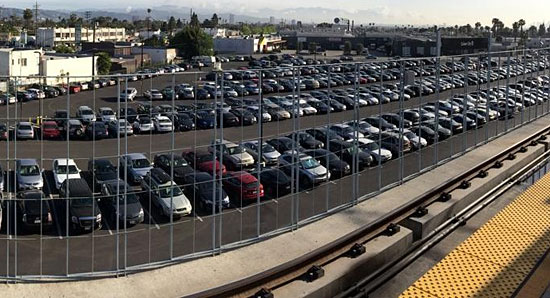
It's also tough to find a parking space at the Expo Line's Culver City station. Photo/Streetsblog LA
Posted 6/25/14
Magic in the muck
June 19, 2014
John Harris loves the smell of asphalt in the morning. As chief curator of the county’s Page Museum at the La Brea Tar Pits, he’s been enjoying the pungent smell since 1980. “I open the door of the car, and I’m here,” he said, demonstrating his appreciation with a dreamy sniff.
Not everyone shares his olfactory pleasure. “It sure smells,” observed a little boy in a baggy yellow T-shirt as he checked out some of the famous black ooze before heading into the museum with his family.
Individual noses notwithstanding, there’s a sweet smell of progress around the iconic tar pits these days. The famous mammoth and mastodon statues by the bubbling lake bed have been spiffed up and, more significantly, two scientific hot spots on the museum campus have been reactivated so that the public can get a sense of the discoveries being made each day right beside busy Wilshire Boulevard.
Beginning June 28, the mid-century Observation Pit—a repository for large Ice Age fossils from throughout the tar pit area—will become a highlight of the museum’s new Excavator Tour, after being closed since the mid-1990s. At the same time, Pit 91 is now open for excavation and public viewing after a seven-year hiatus.
The re-opened sites promise to be tourist attractions, educational resources and must-see stops on any fossil geek’s itinerary. They also mean new jobs. The museum has hired two new excavators for Pit 91. In addition, two new gallery interpreters will lead tours and five new guest relations staffers have been added.
Museum officials said the Observation Pit was closed for many years to allow excavators to concentrate their attention on the very productive Pit 91, site of such key finds as the first confirmed piece of a very young mammoth. But the excavation of Pit 91 eventually ceased because of another treasure trove of fossils uncovered in 2006 during construction of the Los Angeles County Museum of Art’s subterranean parking lot. Page Museum officials decided to focus excavation resources on the new finds, the most renowned of which was a mammoth nicknamed Zed. That ongoing effort is named Project 23 after the number of crates of specimens uncovered there.
Re-opening the Observation Pit and Pit 91 seemed like a good way to give visitors a different vantage point for exploring the museum’s collection, said Jane Pisano, president and director of the Natural History Museum of Los Angeles County, which oversees the Page.
“We have a very exciting opportunity here to preserve the tar pits for present and future scientific discoveries and at the same time do a much better job for our visitors connecting the work outside with what’s on display inside the Page Museum,” Pisano said.
She added that the new exhibits offer a window into the latest scientific thinking on what fossils can teach us. The bottom line: size matters. Smaller is better for examining changes in the environment, including climate change. While it may be sexier to find a big cat or mastodon, “the reason to focus on the smaller fossils is that those critters lived here year round,” Pisano said. “We know the bison and larger animals were migrating and only came here once in a while.”
As chief curator Harris put it: “The real emphasis now is not on the big fossils, because we’ve learned pretty much what we can. Now it’s the smaller fossils and what they can tell us.”
Officials unveiled the new attractions today. Supervisor Zev Yaroslavsky said it’s all part of a virtuous cycle of education and inspiration.
“The more access that people have to the tar pits, the more their curiosity gets piqued. The more their curiosity gets piqued, the better our quality of life is. And one or two of those kids who come here may become scientists who ultimately work for the Natural History Museum, analyzing what’s found underneath these properties,” Yaroslavsky said.
The reactivated exhibits at the tar pits are part of a Miracle Mile boom that includes extending the Purple Line subway and creating a new building at the Los Angeles County Museum of Art, to be designed by renowned architect Peter Zumthor.
“This part of Los Angeles…is on a roll,” Yaroslavsky said. “We are very excited about the future as much as we are curious about the past.”
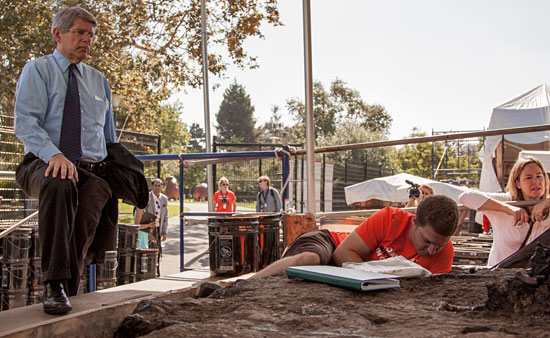
Yaroslavsky checks out some of the fossil excavation efforts taking place on the grounds of the tar pits.
Posted 6/19/14
Voting’s future: #FixIt
June 19, 2014
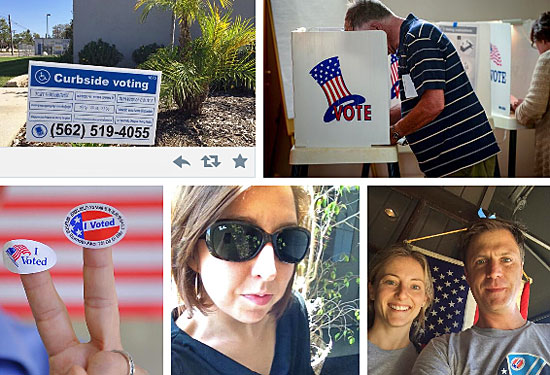
The #LAVote Twitter feed was busy on Election Day, sharing updates and photos from around the county.
After Tuesday’s primary election, Los Angeles County Registrar-Recorder/County Clerk Dean Logan noted the irony of his role the night before: He was using new technology—that is, tweeting—to explain to voters why the county can’t post instant election results on the Internet.
One of his tweets, also posted on the Registrar-Recorder/Clerk’s website : “L.A. County covers a large geographic area. It will take time for secure transport of ballots to HQ (that’s headquarters in Norwalk) for tabulations.”
During the evening, Logan and other county officials kept the Twitter generation entertained with updates and photos of bright red boxes of paper ballots security-sealed and ready for transport. Logan loves the real-time dialogue with constituents, but pleads for patience from those among the county’s 4.8 million registered voters who may blame reporting delays on county staff.
Secure transport of ballots doesn’t begin until the polls close. “Once that’s done, the counting process is fast — but we have to get them to Norwalk,” he said. (Still, as of Wednesday, thousands of “provisional” and last-minute absentee ballots remained to be counted.)
Both tired and exhilarated on Wednesday morning, Logan said it might be a long time before voters can cast their vote online or get instant election results. That’s hard to explain to a public that’s used to doing everything online, from paying bills to voting for the next American Idol.
“What it really comes down to is the value of the history of the secret ballot,” Logan said. He explained that while an online activity such as banking is a secure transaction, it still requires that the identity of the individual be linked to the account so the bank knows who you are. At the polls, the voter signs in so he or she can’t vote more than once, but once the paper ballot is placed in the box it can no longer be connected to any individual voter.
But Logan is more confident that the county can streamline the current voting process to better serve the demands of a new generation of voters in other ways. “We’re looking at modernizing the voting systems,” he said. Tuesday’s startlingly low voter turnout, he said, is one more indicator of a voting process that is “at the end of its life cycle.” (Only 13.1% of eligible county residents voted, the lowest turnout in the state.)
Last year, the county launched a massive updating of the voting apparatus to be more user-friendly, with updated equipment to be available at the polls in 2016, part of a broader effort that includes research into the future needs of an increasingly large and complex population.
And on Wednesday, the county passed an ordinance—initiated by Supervisor Zev Yaroslavsky —that will require candidates to file their campaign finance reports electronically, with the goal of eliminating the slow, labor intensive data entry process and providing quicker, more complete access to the public.
By the November 4 general election, Logan said, campaign donor information will be available online for all candidates. While optional electronic filing has existed for several years, he said, only 50% of L.A. County candidates have been filing online. Some information was only accessible on paper at Norwalk headquarters.
“And some candidates have done a hybrid, sometimes electronically, sometimes paper,” he said. “The first step is to make that an even playing field. All of the candidates will be filing in the same manner.”
He adds that it’s not enough to post campaign finance information: the county plans to make sure it’s presented in a searchable, user-friendly format. (One minor downside: Because the information will be entered online by the candidate’s campaign management, errors or violations will be publicly visible before the county has a chance to see the entry and notify the campaign of the problem.)
Logan called the move significant because “it’s one step in updating the whole process.” The goal of the county, he asserts, is “transparency, security and accountability.”
Logan said his department also is looking at new ways to bring younger voters to the polls, including the opportunity to vote at any polling place, rather than having to make it to a designated polling location during voting hours.
And the poll worker pool needs to be expanded beyond the current demographic, which skews heavily toward older people and retirees. “There is not the population available that’s willing to put in a day’s work for what is essentially a civic volunteerism act,” he said. “Some do it for the stipend, which I think is $175, but there are certainly areas of this county where that’s not an incentive.”
Logan says the department will carefully consider each update to the system. “People are now used to getting information on a real-time basis and our system isn’t designed for that,” he acknowledged. “But we need to make sure we’re not duplicating [problems] with a newer version of the old process. We need to make sure there’s value added, and a flexibility to change with the times.”
Posted 6/5/14
A stowaway on Expo 2
June 18, 2014
I had a chance to ride the rails last week, going behind the scenes of one of L.A.’s most eagerly anticipated transit projects.
The vehicle transporting me was a bouncing truck, not a sleek light rail train. But my imagination was moving full speed ahead as I traveled a major chunk of the Expo Line Phase 2 route now taking shape beside the 10 Freeway. (I even shot some iPhone footage along the way. I’m probably not going to be winning any cinematography Oscars, but I hope you’ll click on the above link to share a condensed and accelerated video version of my off-road voyage.)
When completed next year, and opened to the traveling public in 2016, Expo will be an urban transportation godsend: a chance to bring some predictability and personal choice back to what’s become, over the past decade, the increasingly soul-crushing experience of just trying to get across town.
I was moved—and not only in the literal sense—to see all the years of hard work, planning and construction transforming into something so real and so powerful. The long-held dream of being able to make it from downtown L.A. to 4th Street in Santa Monica in 46 minutes flat is now emerging fast from steel, sweat and stone.
I saw stations rising in Palms and at Westwood Boulevard. Long stretches of sound walls were already in place. About four miles of track have been installed, with 10 additional miles coming soon to complete the roundtrip journey of Expo Phase 2 from Culver City to Santa Monica.
On the morning of my off-road tour, from Bagley Avenue to Military Avenue in West Los Angeles, electrical crews were racing their construction counterparts to put up the network of power poles that will move Expo’s trains. Knots of workers were busily installing pavers on the platform of the Westwood Boulevard station. Elevator towers were up at the Palms Station, ready for the contractor to install glass and machinery. And heavy, laser-equipped machines were preparing to tamp down rock ballast between rail ties.
It was a fascinating trip into L.A.’s past, present and future. We traveled past the modern Lycée Français de Los Angeles; past an area known as Motor Yard where generations of taggers, unfortunately, have left an inch-thick residue of graffiti for our teams to clean up; through an old freight train tunnel under the 10 Freeway that will soon see a new generation of trains gliding through.
To our right, for some of the trip, rumbled the 10 Freeway—moving uncharacteristically smoothly on this morning but inevitably heading toward the gridlock that will be the Expo Line’s best advertisement when Phase 2 opens. As we passed the Westwood Boulevard station, another symbol of motoring frustration, the 405 Freeway, was visible to the west.
It was an amazing vantage point, and I wish that every Angeleno who’s ever cursed a Sig Alert could have been along for the ride. Short of that, I hope that the video above will spur your imagination and awaken the sense that something better is coming down the tracks for Los Angeles.
Posted 6/18/14
County’s $840 million reform plan
June 17, 2014

The county, which pays millions annually for health care for retirees and their dependents, will save substantially in the years ahead.
In a move expected to save hundreds of millions of dollars in the decades to come, the Los Angeles County Board of Supervisors on Tuesday approved historic reforms in the way it pays for county retirees’ health care insurance.
County officials said the changes could save $840 million over the course of the next 30 years. Under the plan—which applies to those hired after July 1, not to current workers—the county will reduce the subsidies it provides for retirees to purchase health care insurance. The changes approved by the board also require retirees who are eligible for Medicare to enroll in the federal program; the county subsidy will be applied to a Medicare supplement plan.
The savings are projected be considerable. Currently, the county pays up to $1,953.41 a month to subsidize health care benefits for a retiree and his or her family. Under the new plan, a retiree under the age of 65 would receive an individual monthly subsidy of up to $918.46, which will be reduced to $370.89 once the retiree reaches 65 and can be covered under Medicare. The new plan is based only on individual coverage, but retirees can still purchase insurance for their dependents at their own expense.
“This represents one of the most significant improvements to our retiree health care benefit since the 1980s. It reduces our unfunded liability by 20%,” said William T Fujioka, the county’s chief executive officer. “It speaks to our board’s fiscal responsibility and fiscal discipline, and it’s a move that will help ensure our future financial viability.”
Fujioka said the support of county labor groups had helped make the new retiree health plan a reality.
“They were with us 100%,” Fujioka said. “We went to the table and negotiated this change, and they joined us in presenting this change to our L.A. County retirement board. As a consequence, we got a unanimous vote.”
The county currently pays about $487.8 million a year for retiree health care—with that obligation coming off the top of the budget each year, before other programs are funded.
Taking action now ensures the health of the retiree benefit in the years ahead, Supervisor Zev Yaroslavsky said.
“These reforms allow Los Angeles County to continue its leadership role in providing fair and responsible benefits to retirees, in contrast to troubles that have affected many other jurisdictions across the country,” Yaroslavsky said. “Without these changes, our health care program would have faced severe challenges going forward. As it is, we are doing the right thing for future generations of L.A. County employees and taxpayers.”
Posted 6/17/14
The whammy on Wilshire
June 12, 2014
As the 405 Project starts to move out of the limelight as L.A.’s most groused-about long-running transportation project, attention is shifting to a new construction hot zone: Wilshire Boulevard.
With a litany of high-visibility public and private projects in the works or on the horizon, the legendary boulevard is gearing up for a years-long building boom, particularly in the Miracle Mile.
“Seriously, if it’s not one thing, it’s another,” said Ginny Brideau, a consultant with The Robert Group who is handling community outreach for one of the projects, a new lane dedicated to buses at rush hour and available to all drivers at other times.
As part of that project, crews already are building special lanes and resurfacing Wilshire from Western Avenue to San Vicente Boulevard—work that entails closing lanes, detouring sidewalk traffic and putting up temporary no-parking signs.
Later this month, things start heating up miles to the west, as work begins on another bus rapid transit segment near the V.A. in West Los Angeles—close to where the 405 Project has been a high-profile challenge for nearly five years. Construction of the short (less than ½ mile long) bus lane on Wilshire between Federal Avenue and Bonsall Avenue will bring lane closures for the next seven months. That includes a period in which traffic will be detoured away from ramps connecting Wilshire to the Bonsall underpass. (Details are here.)
The Wilshire bus project is intended to create a faster-moving 12.5-mile corridor for rush hour riders between MacArthur Park and the Santa Monica border, and to improve traffic for everyone by tempting more people to ditch their cars and hop aboard public transit.
But it’s just the first leg of what promises to be an epic journey on Wilshire. Here’s a brief taste of what’s happening now, or coming down the road soon:
- The project to extend the Purple Line subway from Western to La Cienega Boulevard is currently busy with utility relocation, including after-hours jackhammering and saw-cutting. The action is expected to intensify in the months ahead when demolition begins on the first of 17 buildings set to come down to create staging areas for the project. Actual subway construction, including pile-drilling and station excavation, will start next year, according to a timetable presented at a recent community meeting. A more immediate impact: next week’s closure and relocation of Metro’s Wilshire/LaBrea customer service center.
- At the same time, private developers have started work on the Desmond on Wilshire, a new 7-story apartment structure in the Miracle Mile that’s expected to be finished by next summer.
- Then there’s the new Academy of Motion Pictures Arts & Sciences museum, designed by Renzo Piano, to be built on the old May Co. site at Wilshire and Fairfax Avenue and heading for a 2017 debut.
- Right next door, the Los Angeles County Museum of Art is developing plans of its own for a new building by Pritzker Prize-winning architect Peter Zumthor to open in 2023, replacing several aging buildings on the museum campus.
In the scheme of things, the Wilshire bus rapid transit project is expected to wrap up relatively quickly, by next year.
“I’m thrilled that it’s going in,” said James O’Sullivan, president of the Miracle Mile Residential Association. “It’s made a mess out of Wilshire, and 8th Street has become a jungle at times. But it’s short term.”
There’s a much longer road ahead for the subway extension.
“Our issue all along has simply been: we don’t understand how we can do nine years of this, 24/7,” O’Sullivan said. “We know it’s coming. We know it’s going to go in. We have lots of questions.”
Complicating matters is the sometimes confusing welter of agencies with a piece of the action: the county is building the bus lane from Federal to Bonsall, the city is constructing the rest of the bus rapid transit project, Metro is in charge of building the subway and is funding much of the bus lane work, utility companies are out in force moving lines in support of a variety of projects, and the Los Angeles Police Commission is responsible for canvassing residents and businesses when a project needs an exemption from work hours requirements under the city’s noise ordinance.
In the midst of all that, consultant Brideau said she understands how people feel when they experience problems: “You don’t care who it is, you just want it to stop.”
She recently came to the rescue of a toy store owner who arrived one day to find that a contractor had unceremoniously installed a portable restroom right in front of her business. Brideau also has been known to remove no-parking signs left up too long after bus lane work has concluded.
Calls to the bus rapid transit project’s hotline—(213) 922-2500—are promptly returned, Brideau said, and so are messages left on its Facebook page.
As for the subway, project director Dennis Mori acknowledges there’s a lot going on, but said the results—new transportation and cultural facilities that will provide a broad public benefit—will be worth it in the end.
“We look forward to the opportunity of integrating our plans and construction activity with the other projects,” Mori said. While there’s lots of coordination ahead, he said, the agency has been there before on other successful endeavors.
“We’ve had those experiences in the past,” he said, pointing to collaborative work between Metro’s Red Line subway team and the group building the Hollywood & Highland center. “We had very busy schedules and both parties worked very closely together.”
Posted 6/11/14
New CicLAvias to hit the road
June 12, 2014
L.A. has tasted CicLAvia, and it wants more.
In early 2010, as preparations were being made for Los Angeles’ first car-free, open streets event, Santa Monica organizers were brainstorming doing the same thing in their city. While CicLAvia blasted off that October, quickly drawing crowds in excess of 100,000, Santa Monica’s plans never got rolling.
Cynthia Rose, director of the bike advocacy group Santa Monica Spoke, said that despite having an active cycling and walking community, her city simply didn’t have enough resources.
“We were not as far along and just did not have the money that CicLAvia had,” says Rose.
Enter Metro.
A year ago, the transportation agency launched a grant program to fund open streets events—closing streets so people can bike, walk and frolic freely—with the goal of spreading the CicLAvia love to more places. Nearly two dozen applications were received in April, and 12 were accepted in the first cycle of grants made public this week. Pending approval by Metro’s Board of Directors, the agency will spend $4 million during the next two years to bring 12 events to places like Santa Monica, Pasadena, Long Beach and the San Fernando Valley.
Rose says she’s excited that her city will now get a chance to put its unique mark on the rapidly-expanding open streets movement, which was initially inspired by mid-1970s ciclovias in Bogotá, Colombia. (“Ciclovia” translates roughly to “cycleway.”)
“This is something that the community is ripe for and really wants,” Rose says. “Ours is going to be more like a big street festival. It’s for everyone to share the street.”
The Santa Monica gathering is being planned for spring or summer of 2016, to take advantage of the excitement surrounding the opening of Expo Line Phase 2, which will extend the light-rail train from downtown L.A. to the coast. Rose hopes the event will highlight some of the investments that Santa Monica has made to improve bicycle and pedestrian infrastructure, including the Bike Center and L.A. County’s first-ever bike share program, which should be up and running in two years.
Still, a large chunk of the grant money is slated to go CicLAvia itself, with funding recommended for six major events that the organization is producing or co-producing. CicLAvia spokesman Robert Gard said the plan is to use the Metro money to reach new locations, including the San Fernando Valley, where an event is planned for spring of 2015.
“We’ve done nine events on this side of the hill and by the time we get to the Valley it will have been 11 events,” Gard said. “With all the people who come from the Valley and beyond to our events, it just makes sense.”
The proposed Valley route still must be tested and finalized, but planners envision it going through North Hollywood, Studio City and Sherman Oaks, along Ventura and Lankershim boulevards. Those streets are home to scores of shops and eateries, a thriving arts community, beautiful vistas of the Hollywood Hills and more. The route also would connect with Metro’s Red and Orange lines and several bike paths, making it easy to get there and back.
CicLAvia would like to make the San Fernando Valley a regular destination, Gard says. Future events could target other locations further west.
The Metro grants will also help smaller towns join the open-streets movement, with tens of thousands of dollars going to places like Carson, Downey and Lawndale for more modest-scale events.
“Anybody who hopes for public consciousness of bicycling hopes a ciclovia makes it into their community,” says Lars Clutterham of the Downey Bicycle Coalition. He says that, unlike Santa Monica, “Downey is in the early stages of investing in bicycle infrastructure—there is none.” Clutterham hopes that the prospect of open streets events will prompt investment in pedestrian and bicycle improvements.
Viviana Franco is the executive director of Lot to Spot, an organization behind the Lawndale Community Bicycle Ride and Open Street Event, another grant winner. She hopes Metro’s program is a tipping point for low income communities that have largely missed out on the events. Franco says that’s upsetting because people in these communities are already cycling and walking to get where they need to go, but are unable to take full advantage of the health and community-building that can come with those activities.
“CicLAvia is amazing,” Franco says. “Let’s bring it to other neighborhoods; let’s bring it to neighborhoods where diabetes and obesity are rampant.”
Under direction from its board, Metro has sharpened its focus in recent years on “active transportation,” including cycling and walking. The agency formed a Bicycle Roundtable to collaborate with the cycling community and it has invested millions in infrastructure, with more to come.
Diego Cardoso, Metro’s executive officer in charge of active transportation, says open streets events benefit all types of transportation in the county. Not only do they get people out of their cars, he says, they also get some folks to try public transit for the first time.
“They take transit because they are going to use a bike at CicLAvia, but then they learn the places it can take them.” That, Cardoso says, makes them more likely to take buses and trains in the future.
The proposed grant awards go to the Planning and Programming committee next Wednesday before reaching the full Board on June 26.
Posted 6/12/14
Moving forward at Descanso
June 11, 2014
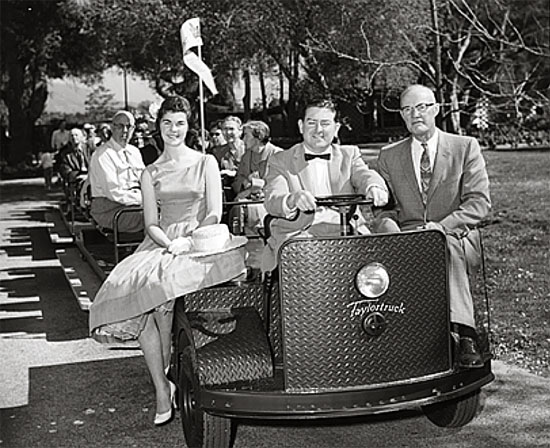
Trams have been a fixture at the gardens since the 1960s. But they've now come to the end of the road.
When an early morning fire engulfed a storage structure at Descanso Gardens in January, a bit of history went up in smoke. And maybe that wasn’t so bad, admits the garden’s executive director, David R. Brown.
Descanso’s vast botanic collection completely escaped the blaze that took firefighters about 2 hours to extinguish. But the flames devoured virtually all of the Los Angeles County facility’s tools and vehicles—including trams that had ferried visitors around the 160-acre grounds since the early 1960s.
While the trams were part of Descano’s longtime culture, they also were “very large and noisy and intrusive,” unable to deliver people to some of the garden’s most popular but secluded spots, according to Brown. That included the historic Boddy House, with a hilltop setting too challenging for many of Descanso’s elderly, disabled or simply out-of-shape visitors to reach.
In all, Brown said, only 8% of Decanso’s 250,000 annual visitors were boarding the trams, which would sit idle on busy weekends because they were too unwieldy for the garden’s crowded walkways.
In visitor surveys, Brown said, “mobility came up over and over and over again, that it’s not comfortable to walk here.” The fire, he said, “allowed us to rethink the notion of a superior visitor experience.”
Among other upcoming changes, Brown said, the trams will be replaced by electric-powered shuttles—essentially big golf carts—that will transport as many as six passengers into regions previously accessible only by foot. The shuttles will be free and compliant with the Americans with Disabilities Act—unlike the $4-a-ride trams.
The timing, Brown said, couldn’t be better. In the months ahead, Descanso will open a 5-acre exhibit in a previously-closed section of the gardens. Promotional materials say the undertaking will replicate and honor the region’s native landscape of oak woodlands, meadows and chaparral—an ecosystem that has been increasingly threatened by aggressive development. The new shuttles, he said, are key in helping the Oak Woodland Project find its audience.
“We wanted to give people access to the further reaches of the gardens,” Brown said, “so they can have a physical experience with a landscape that typified Southern California before it was explored and developed.”
Descanso gardens has long been considered one of Southern California’s premiere public gardens, perhaps best known for its thousands of towering camellias and expansive rose garden. Located in affluent La Canada Flintridge, in the shadow of the San Gabriel Mountains, Descano was founded by E. Manchester Boddy, the former publisher of the Los Angeles Daily News. He sold the property—including his 22-room mansion—to Los Angeles County in 1953.
Brown, the former president of Art Center College of Design, was named executive director of Descanso in 2005 by the Board of Supervisors.
Beyond the trams, he said other vehicles and equipment destroyed in the fire also will be replaced with more efficient, environmentally-friendly versions through insurance, county funding and foundation grants.
Still, everything post-fire isn’t coming up roses—or camellias, as the case may be. Damage from the fire, which apparently was sparked by an electrical problem, has been estimated to be as high as $750,000. And some of the items reduced to ash were priceless—including two old refrigerated boxcars owned by Boddy.
“Mythology holds that Mr. Boddy once used them to ship his camellias to customers in the Midwest and on the East Coast,” Brown said.
But overall, now that the smoke has cleared, the opportunities are clear.
“In a way, the fire was sort of a cleansing experience,” Brown said. “It kind of pulled us together.”
Posted 6/11/14





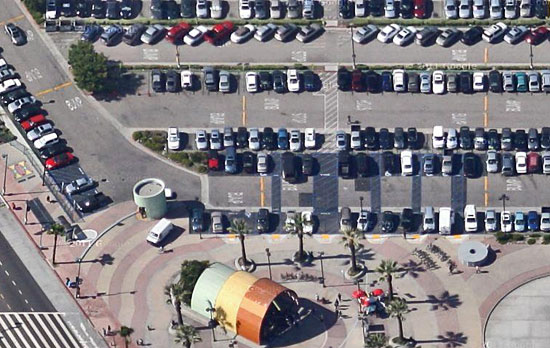
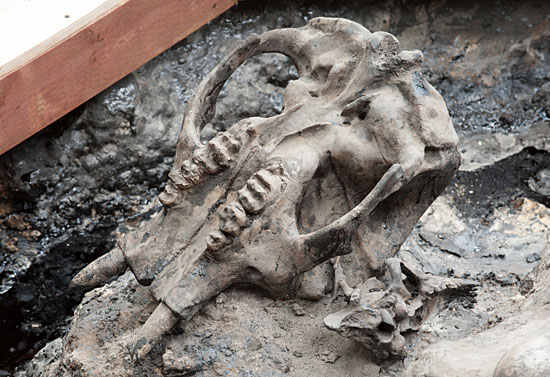
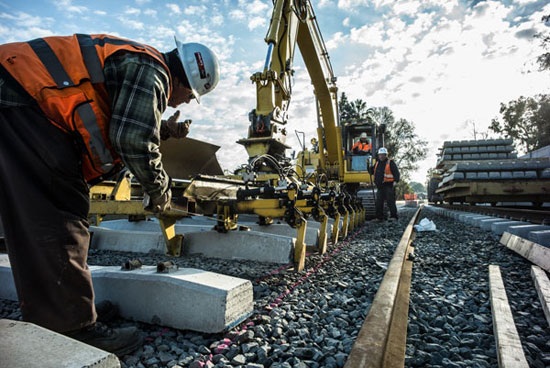
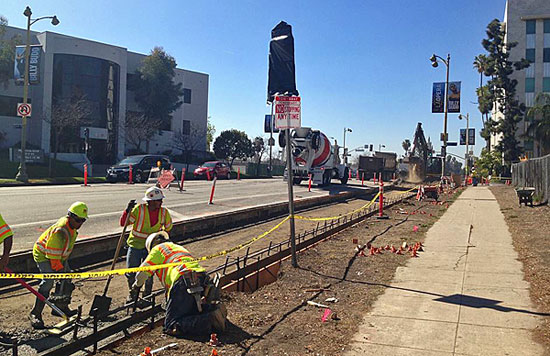
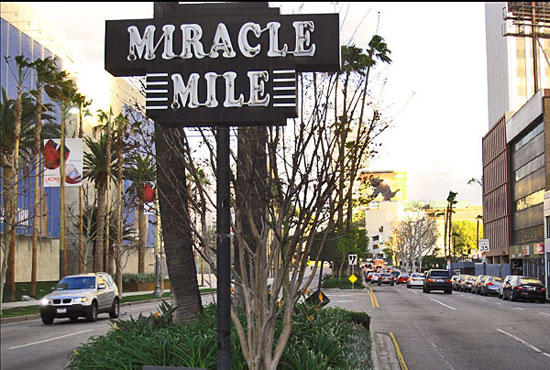


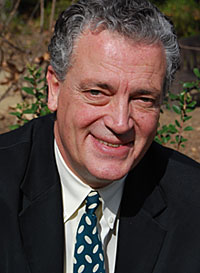
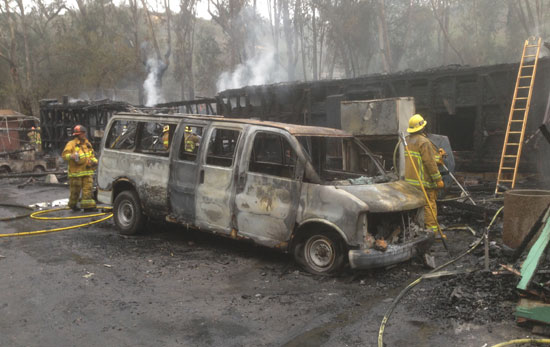





 Check for the latest closure information
Check for the latest closure information








